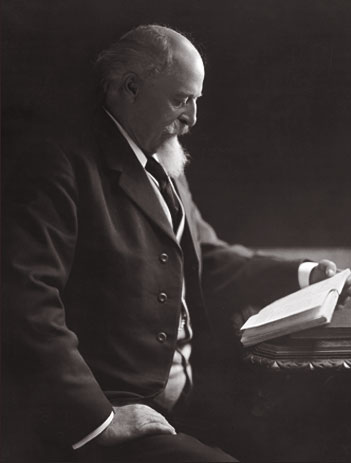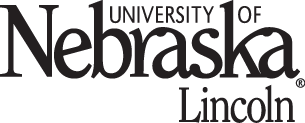
Buffalo Bill's Wild West and Congress of Rough Riders. Col. W. F. Cody. (Buffalo Bill), President. Nate Salsbury. Vice-President & Manager.
of the World.
John M. Burke. General Manager.
Albert E. Sheible, Business Manager.
Jule Keen, Treasurer.
Aug. 31 st 96 My Dear Beck.
 2). I have said before wait for my pay until Bonds can be placed. You your place is right there— we are all working to place the Bonds. You can be of much more service there. Say George— What would it cost to Bridge the river
[5] there at Town? I believe the best play you could make just now is to get up an excitement that we are going to bridge the river— And have a mail route established through to Red Lodge
[6] west of Heart Mountain.
[7] And you can make a ten strike by going over a route get Chapmans
[8] and the people along the route to assist in fixing and laying out a road. Go to Red Lodge and call a meeting and get the Red Lodge people worked up to help build the road. Take the Chapmans to Red Lodge with you to help. It will create an excitement and help to win the County Seat. If a bridge can be built across river for a $1.000 I will agree to build it— And wait for my money if I can ever get it back. I wish you would give me some suggestions And your views. also wish you would write each member of our Co. You could do a great deal to give them encouragement and spur them up if you would write them fully and get them enthused. Now George
2). I have said before wait for my pay until Bonds can be placed. You your place is right there— we are all working to place the Bonds. You can be of much more service there. Say George— What would it cost to Bridge the river
[5] there at Town? I believe the best play you could make just now is to get up an excitement that we are going to bridge the river— And have a mail route established through to Red Lodge
[6] west of Heart Mountain.
[7] And you can make a ten strike by going over a route get Chapmans
[8] and the people along the route to assist in fixing and laying out a road. Go to Red Lodge and call a meeting and get the Red Lodge people worked up to help build the road. Take the Chapmans to Red Lodge with you to help. It will create an excitement and help to win the County Seat. If a bridge can be built across river for a $1.000 I will agree to build it— And wait for my money if I can ever get it back. I wish you would give me some suggestions And your views. also wish you would write each member of our Co. You could do a great deal to give them encouragement and spur them up if you would write them fully and get them enthused. Now George

Buffalo Bill's Wild West and Congress of Rough Riders. Col. W. F. Cody. (Buffalo Bill), President. Nate Salsbury. Vice-President & Manager.
of the World.
John M. Burke. General Manager.
Albert E. Sheible, Business Manager.
Jule Keen, Treasurer.
Show. I feel sure I could place those Bonds—
George— You and I started that enterprize. Lets carry it through. Give every member of Co three letters a day until you get them worked up—
BillNote 1: Buffalo Bill's Wild West performed in Sheboygan, Wisconsin, August 31, 1896. The day's entry in the 1896 Route Diary: "Sheboygan, Wis. / Monday, August 31. We had to borrow hose from the city in order to sprinkle the arena, it was so sandy, and at night all wagons had to be hook-roped off the lot. At 4 P. M. over two thousand people stood on the bluff to see our Indians go to bathing in the lake. We had for supper some of the fish that the "Fu-kort" Club caught yesterday. / Weather, clear and cool. / Business, in the afternoon big, fair at night. / Lot, So. Eighth and Tellingham streets." [back]
Note 2: The "Town" was officially named Cody, Wyoming, in August 1896. [back]
Note 3: "Bluff" or "Red bluff" is Red Bluffs, a formation to the south and west of Cody, Wyoming, that stands out among the mountainous formations due to its red color. [back]
Note 4: Charles Trego (1856-1925), a personal friend of Cody's and foreman for both Scout's Rest Ranch in North Platte, Nebraska, and the TE Ranch in Cody, Wyoming. [back]
Note 5: Shoshone River. [back]
Note 6: Red Lodge, Montana, lies 65 miles north of Cody and was the closest rail line to Cody, Wyoming. [back]
Note 7: Heart Mountain is an 8,123-foot limestone and dolomite mountain just north of Cody, Wyoming. [back]
Note 8: In 1879 John Chapman (1850-1933) trailed cattle from Oregon and established his ranch near the present-day location of Two Dot Ranch north of Cody. [back]
Note 9: Named for Otto Franc (1846-1903), a local cattle baron who ranched in the Big Horn Basin from the late 1870s until his death in 1903, the small, unincorporated community of Otto is located east of Cody and within a few miles of Burlington and Emblem, Wyoming. [back]
Note 10: Robert Alexander Maxwell (1838-1912) from Batavia, New York, was appointed Fourth Assistant U.S. Postmaster by President Grover Cleveland in 1893 and served until the end of March 1897. [back]


